Lexus Is350 Top Speed
Motor vehicle
| Lexus SC | |
|---|---|
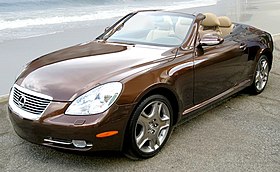 2008 Lexus SC 430 | |
| Overview | |
| Manufacturer | Lexus (Toyota) |
| Also called | Toyota Soarer (1991–2005) |
| Production | 1991–2010 |
| Body and chassis | |
| Class | Grand tourer Personal luxury car |
| Layout | Front-engine, rear-wheel-drive |
| Chronology | |
| Predecessor | Toyota Soarer (Z20) |
| Successor | Lexus LC |
The Lexus SC (Japanese: レクサス・SC, Rekusasu SC) is a grand tourer that was retailed by Lexus (a luxury vehicle division of Toyota), and built from 1991 through 2010. It features a front-engine, rear-wheel-drive design and seating for up to four passengers. The first-generation SC debuted as the V8-powered SC 400 in 1991, and the I6-powered SC 300 was added in 1992. Both first-generation models were produced until 2000. The second-generation model, the SC 430, went into production in 2001. The SC 430 features a hardtop convertible design and a V8 engine. The first-generation SC was largely styled in California at Calty, and the second-generation SC was mainly conceived at design studios in Europe.
In Japan, the related third-generation Toyota Soarer, with which the first-generation SC originally shared body design and multiple components, featured a separate line-up of vehicle configurations and different powertrains. The third generation Soarer sport coupe, largely identical to the SC 430, was superseded by its Lexus counterpart in Japan when the Lexus marque débuted there in 2005. The SC was the sole coupé in the Lexus lineup until the arrival of the IS C.[1] According to Lexus, the SC designation stands for Sport Coupe.[2] The LC replaced the SC lineup in 2017.
First generation (Z30; 1991) [edit]
Motor vehicle
| First generation (Z30) | |
|---|---|
 1994-1996 Lexus SC 300 | |
| Overview | |
| Also called | Toyota Soarer |
| Production | 21 April 1991 – 7 July 2000[3] |
| Model years | 1992-2000 |
| Assembly | Japan: Susono, Shizuoka (Higashi Fuji plant);[4] Toyota, Aichi (Motomachi plant)[3] |
| Designer | Erwin Lui and Denis Campbell (1988–1989) |
| Body and chassis | |
| Body style | 2-door coupé |
| Related | Toyota Supra (A80) |
| Powertrain | |
| Engine | 3.0 L 2JZ-GE I6 (SC 300) 4.0 L 1UZ-FE V8 (SC 400) |
| Transmission | 4-speed A340E (1992-00 SC 300, 1992-97 SC 400) / A341E (1992-99 SC 400 GT-L) automatic 5-speed A650E automatic (1998-00 SC 400) 5-speed W58 manual (1992–97 SC 300) |
| Dimensions | |
| Wheelbase | 105.9 in (2,690 mm) |
| Length | 191.3 in (4,859 mm) (1992–97) 192.5 in (4,890 mm) (1998-00) |
| Width | 70.5 in (1,791 mm) (1992–97) 70.9 in (1,801 mm) (1998-00) |
| Height | 52.4 in (1,331 mm) (1992–94 SC 300) 52.6 in (1,336 mm) (1995–97 SC 300 & 1992–97 SC 400) 53.2 in (1,351 mm) (1998-00 SC 300/400) |
| Curb weight | 3,485 lb (1,581 kg) (1992 SC 300 manual)[5] 3,505 lb (1,590 kg) (1992 SC 300 automatic) 3,604 lb (1,635 kg) (1992 SC 400) |
1991–2000 [edit]
In the early 1990s,[6] following the début of Lexus, automotive press reports indicated a forthcoming Full-size Lexus coupé to compete with other luxury GT coupés of other marques like the Mercedes-Benz CL, Acura Legend coupe and later the Acura CL, Mazda Eunos Cosmo, Buick Riviera, Cadillac Eldorado, Lincoln Mark VIII, Jaguar XJS, Bentley Continental, Maserati Shamal/Ghibli, Ferrari 456 and BMW 8 Series coupe. At that point, Toyota had no genuine luxury coupés in its model range. A coupe would complement the successful Lexus flagship model, the V8-powered, rear-wheel drive LS 400 sedan.[6] The coupé was going to be targeted towards the American market,[7] and the development effort for its exterior design was handed over to the Calty Design Research center in California in 1987.[6]

The American Calty design team took a different approach to designing the car,[8] using plaster molding shapes to design the body,[6] and working three-dimensionally instead of the traditional 2-D sketch approach.[6] As described by design chiefs Denis Campbell and Erwin Lui,[6] the result was a car that was based on "emotion and feeling" rather than linear aesthetics. The resulting design possessed almost no straight edges, and produced a drag coefficient of C d =0.31.[6] [9] The production design concept by Lui was approved at the beginning of 1989, resulting in Lui being sent back to Japan for 4 months to assist in completion of the production design.[10] According to automotive journalist Bill Russ, the SC design was considered influential among automotive designs of the time.[7]
Production of the Soarer started in April 1991 at the Motomachi plant in Toyota, Aichi,[3] with the Lexus SC produced alongside the Soarer at a second Higashi Fuji plant at Susono, Shizuoka.[4] Motomachi-sourced cars lasted until April 1997.[3] The Lexus SC platform was used to develop Toyota's next generation Supra, both vehicles were manufactured in the same plant.[11]
The SC 400 débuted on 1 June 1991 in the United States as a 1992 model. The SC 400's 4.0 L V8 1UZ-FE, the same engine as used in the LS 400, was reported to have cost over US$400,000,000 in research and development.[12] The engine sits behind the front axles, which makes it a front mid engine rear wheel drive vehicle. The SC 400 was honored as the Motor Trend Import Car of the Year for 1992. It also made Car and Driver magazine's Ten Best list from 1992 through 1996.
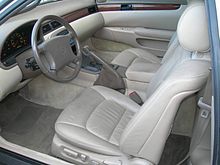
In July 1992, the SC 300, a smaller-engined version of the SC 400, premiered in the United States. The SC 300 was equipped with a 3.0 L inline 6 2JZ-GE. [13] Lexus' traction control system, TRAC, was offered as an option.[13]
The first-generation SC lasted in production until 7 July 2000, over nine years, quite long compared to the other cars of the 1990s.[2] Even with the SC's long production cycle, only minor exterior changes were made. New tail lighting and a modified spoiler design was part of the mid-cycle vehicle refresh. A front grille was added in 1996, along with a redesigned front bumper, side skirts and rocker panels. The SC 400 produced 250 hp (186 kW)/260 lb⋅ft (353 N⋅m) from 1991 to 1995.[14] The original 1991–1997 engines for the 2JZ-GE-powered SC 300 were rated at 225 hp (168 kW)/210 lb⋅ft (285 N⋅m). The output of the SC 300 was 5 horsepower more than the equivalent engine used in the Toyota Supra.[15]
In 1996, the SC 400's 1UZ-FE engine design was upgraded to 260 hp (194 kW) from 250 hp (186 kW). These engines were coupled with a 4-speed automatic transmission on both the SC 300 and SC 400 models. A 5-speed manual transmission was only offered on the SC 300 from its debut until 1997.
By the end of the decade, North American SC sales began dwindling due to the lack of significant design updates since the car's introduction and marketplace changes that led to loss of interest in coupes.

In 1997 (1998 model year), both the SC 300 and 400 were upgraded with VVT-i and thus the ratings were raised to 290 hp (216 kW)/300 lb⋅ft (407 N⋅m) of torque for the SC 400 and 225 hp (168 kW)/220 lb⋅ft (298 N⋅m) of torque for the SC 300. Tests conducted on the new engines showed an acceleration for the SC 400 for years 1992–1995 of 0–60 mph in 6.9 seconds, years 1996–1997 in 6.7 seconds, and years 1998–2000 in 6.1 seconds. For the SC 300 an acceleration 0–60 mph in 6.8 seconds with the 5-speed manual and 7.2 seconds with the 4-speed automatic for all years.[16] This 1997 upgrade included the replacement of the four-speed automatic on the SC 400 to a five-speed unit. With the replacement of the five-speed unit those models also got a new differential with a final drive of 3.27 improving both fuel economy and top speed.
Sales of the automatic transmission SC 300 and SC 400 models formed the vast majority of models purchased.[17] The Lexus SC 400 was never officially sold in the British Isles, but many examples found their way across the Atlantic as personal imports.[18]
Second generation (Z40; 2001) [edit]
Motor vehicle
| Second generation (Z40) | |
|---|---|
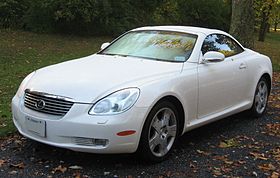 2001–2005 Lexus SC 430 (US) | |
| Overview | |
| Also called | Toyota Soarer (Japan, 2001–2005) |
| Production | January 2001[19] [20] – July 2010[4] |
| Model years | 2001-2010 |
| Assembly | Japan: Susono, Shizuoka (Higashi Fuji plant)[4] |
| Designer | Sotiris Kovos[21] (1997–1998) |
| Body and chassis | |
| Body style | 2-door coupé convertible |
| Powertrain | |
| Engine | 4.3 L 3UZ-FE V8 |
| Transmission | 5-speed A650E automatic (2002–05) 6-speed A761E automatic (2006–10) |
| Dimensions | |
| Wheelbase | 103.1 in (2,619 mm) |
| Length | 177.8 in (4,516 mm) (2002–05) 178.5 in (4,534 mm) (2006–10) |
| Width | 72.0 in (1,829 mm) |
| Height | 53.1 in (1,349 mm) |
| Curb weight | 3,840 lb (1,742 kg) |
2001–2005 [edit]
At the 1999 Tokyo Motor Show, Lexus displayed its Sport Coupe concept, a V8-powered convertible, signifying its plans for a replacement for the first-generation SC 300/400.[2] The production version of its new sports coupe-convertible, the SC 430, debuted at the New York Auto Show in April 2000.[22] The car was scheduled to go on sale in the second quarter of the following year.[23] Power was provided by a 4.3 L 3UZ-FE V8 engine with variable valve timing (VVT-i) mated to a five-speed automatic transmission. This engine was the same model as that found in the UCF30 Lexus LS. The SC 430's V8 could produce 288 hp (215 kW) and 430 N⋅m (317 lb⋅ft) of torque, allowing the coupe to go from 0–60 mph in 6.2 seconds.[24]
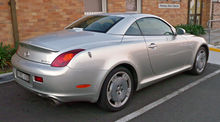
In contrast with the previous generation model, the redesigned Lexus SC was intended as a convertible from its inception.[25] The development team was led by chief engineer Yasushi Nakagawa from 1996 to 2000. Lexus designers from Europe and Japan worked together to create a streamlined design. A design theme was chosen in 1997 developed by Sotiris Kovos, who in return was named chief designer. Led by Kovos, designers travelled to the Côte d'Azur to develop the vehicle's exterior shape, and studied the region's architecture, lifestyle, and harbors.[23] The resulting convertible of 1998 received character lines similar to the region's yachts, in contrast with traditional waveform lines.[26] The vehicle's side profile, the product of extensive wind tunnel testing, was intended to channel air around the passenger compartment at high speed during top-down driving. Design patents were filed in Japan, at the Japan Patent Office on 14 June 1999 under patent number 1095312.[26]
The SC 430 chassis featured a double-wishbone setup for both the front and rear wheels.[25] The vehicle platform shared elements with the GS 430 sport sedan, including variable-assist power rack-and-pinion steering.[26] Safety systems ranged from traction control to vehicle stability control.[25] The convertible received a ULEV emissions certification rating.[25]
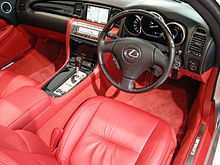
Interior, 2005–2010 Lexus SC 430 (Japan)
The SC 430 featured a retractable aluminium hardtop, all-leather interior with brushed-aluminum accents, navigation screen with folding wood panel, and 18-inch aluminium wheels.[26] Chrome Lexus emblems were mounted on the back of the front seat headrests.[25] The coupe has four seat belts and could technically seat four, but rear-seat space is limited.[27] The hardtop fully retracts in 25 seconds.[25] Standard luxury features include Burl Walnut or Bird's Eye Maple wood trim, a Mark Levinson premium sound system, DVD-based navigation system, and headlamp washers. For additional trunk space, as an option the SC 430 could be equipped with run-flat tires.[25]
At its launch, the SC 430 was marketed as the "jewel of Lexus", and as the marque's first convertible, was intended as a more ostentatious addition to the Lexus lineup.[25] Reviewers from Car and Driver magazine praised the SC 430 for 2002 as "an unqualified success", calling it "comfortable, fast, smooth, and quiet" with "all of the virtues expected in a patrician roadster."[28]
In 2004, Lexus unveiled the Lexus SC "Pebble Beach Edition", a limited-production model of the SC. The special edition SC was produced in partnership with the Pebble Beach Company , and featured a unique exterior and interior color combination which changed with each model year. This edition was offered for model years 2004 through 2009 production of the Pebble Beach edition was limited to varying units each year (see table below for counts). Each Lexus SC Pebble Beach edition coupe exhibited: unique colors (changed each year), special badging (featuring the "Lone Cypress" logo) on the front fenders, center console, and floor mats. For the 2006 model, a rear spoiler and spider alloy wheels was also included. In October 2009 Road & Track published some pictures of that model year.[29]
In 2004 and 2005, J.D. Power and Associates' Initial Quality Survey awarded the SC 430 as the highest ranked premium luxury vehicle.[30] [31] Kelley Blue Book gave the SC 430 its Best to Hold Value Award in 2002.[32] In June 2004, a custom-designed Carolina Herrera SC 430 was shown at the Madrid Motor Show.[33] The special edition SC 430 CH used a 'Testa di Moro' body color, with matching interior leather and carpeting, along with designer logos on the wheels and door sills.[34] A line of accessories was also developed for the vehicle.
In 2012, Top Gear presenters Jeremy Clarkson and James May chose the Lexus SC 430 as the worst car ever built in their film The Worst Car in the History of the World. They criticized its handling, ride and style, with May calling the ride "absolutely diabolical", and stated that a big manufacturer should have known better.

2005–2010 Lexus SC 430 (Germany)
2005–2010 [edit]
In 2005 for the 2006 model year, the SC 430 was updated, with changes that included redesigned alloy wheels and the introduction of Bluetooth capability. In late 2005, the SC 430 premiered along with the Lexus marque in Japan; it was manufactured at the Kanji (Kanto Jidosha) assembly site in Japan.[35] The SC 430 was sold in North America, Europe, Oceania, and Asia; unlike its predecessor, the SC 430 was officially imported to the British Isles;[36] the old SC 400 had been a popular personal grey import.[18]
In 2010, a final special edition model for Japan, the SC 430 Eternal Jewel edition, was produced, limited to 200 units.[37] The 2010 model was the last automobile from any major manufacturer in the United States to ship with a cassette tape deck.[38]
Production of the second-generation SC ended in July 2010 after nine years of production, but Lexus was still using them in the Super GT until the 2013 season ended.[39]
Replacement [edit]
In July 2008, Edmunds InsideLine had reported that Lexus had cancelled the next generation SC due to slowing sales.[40] A company spokesman did not confirm or deny the rumors, but called the report in the possible replacement with the introduction of the Lexus LFA as "unfounded speculation."[41] Lexus subsequently announced the production of the SC 430 model for 2009,[42] and in 2010.

Designated LF-LC for Lexus Future-Luxury Coupe, the concept two-door vehicle premiered in January 2012 at the North American International Auto Show. The vehicle's exterior and interior styling was created by the Calty Design Research center in Newport Beach, California, which previously developed the exterior styling of the first-generation Lexus SC coupe.[43]
The LF-LC features a front-engine, rear-wheel drive drivetrain layout, which incorporates a next-generation Advanced Lexus Hybrid Drive system.[44] The interior features a remote touchscreen control system linked to two liquid crystal display (LCD) screens that measure 12.3 inches (310 mm) in width.[44] Smartphone-size touchscreens are placed on the door armrests for additional controls.[45]
The LF-LC was produced as a design study for a driver-focused vehicle at the direction of the Lexus Center in Japan, and work began on the concept in May 2010.[43] The exterior appearance of the LF-LC was inadvertently leaked by Road & Track magazine several weeks prior to its scheduled auto show debut, when a preview of its February 2012 issue with the LF-LC on its cover (under the headline "Stunning! New Lexus Super Coupe") was posted to YouTube.[46]
A series production model inspired by the 2012 LF-LC Concept is being developed under the Toyota 950A development program. Introduced at the 2016 North American International Auto Show, it went on sale as the Lexus LC 500 in early 2017, based on the new Toyota GA-L modular rear-wheel drive platform and the fifth generation LS flagship.[47]
-
LF-LC with spindle grille
-
Side of the LF-LC
-
Rear of the LF-LC
Motorsport [edit]

SC 430 ENEOS Super GT racer.
In 2006 the SC 430 was entered in the (Super GT) race series in the GT500 class (cars with approximately 500 horsepower). Extensively modified from the factory car, the engine used is a modified version of the SC 430's 3UZ-FE V8 that was also used in the Toyota Supra racing car from previous years.
The new SC 430 based race cars were immediately competitive with former GT500 champion Juichi Wakisaka and no. 2 driver André Lotterer driving the Open Interface TOM's SC to victory at the opening round at Suzuka giving the SC 430 its first victory on its debut race.[48] Juichi Wakisaka and Andre Lotterer also won the GT500 class championship during the same year. In 2007, the Lexus SC fully replaced Supras in the Toyota side, a Zent Cerumo SC 430 driven by Yuji Tachikawa was victorious in the GT500 opening round race.[49]

SC 430 Petronas GT500 racer.
In 2008, a Zent Cerumo SC 430 driven by Yuji Tachikawa and Richard Lyons won the Fuji 500 race, round 3 of the Autobacs Super GT at Fuji Speedway.[50] In 2009, five SC 430s were entered in Super GT racing in the GT500 class, including the Petronas TOM's SC 430 driven by Juichi Wakisaka and André Lotterer, along with the Eneos SC 430, Kraft SC 430, Dunlop Sard SC 430, and Zent Cerumo SC 430.[51]
In 2009, the Lexus Team Petronas TOM's SC 430 driven by André Lotterer and Juichi Wakisaka was the championship winner in the GT500 series,[52] also the SC 430 was victorious in early rounds at the Suzuka Circuit.[53] In 2010, the SC 430 continued in Super GT competition, where the MJ Kraft SC 430 and other Lexus Team Kraft SC 430s won victories at the 2010 Autobacs Super GT at Fuji Speedway.[54] Starting from 2009 until 2013, the SC 430s used Toyota's 3.4L RV8KG V8 engine.
In 2012, two years after production had ended the 430 continued to be a force in Motorsports. Namely in Formula Drift with the Achilles Radial Lexus SC430 powered by a 2JZ and piloted by Daigo Saito.[ citation needed ]
Sales and production [edit]
Sales and production data for the first and second generations, based on manufacturer's data:
| Chassis code | Model no(s). | Calendar year | Total sales, U.S. | Production figures | ||
|---|---|---|---|---|---|---|
| SC 400 AT | SC 300 AT (MT) | Total | ||||
| UZZ30/JZZ31 | SC 400/300 | 1992 | 20,677[55] [56] | 19,212 | 7,074 (1,601) | 27,887[57] |
| 1993 | 16,075[55] | 9,809 | 6,036 (910) | 16,755[58] | ||
| 1994 | 11,929[55] | 3,675 | 1,978 (227) | 5,880[58] | ||
| 1995 | 7,906[55] | 9,750 | 5,329 (793) | 15,872[58] | ||
| 1996 | 5,047[55] | 2,413 | 2,118 (232) | 4,763[58] | ||
| 1997 | 5,041[55] | 2,261 | 2,509 (120) | 4,890[58] | ||
| 1998 | 3,009[55] | 1,189 | 1,582 | 2,771[58] | ||
| 1999 | 2,557[55] | 905 | 1,910 | 2,815[58] | ||
| 2000 | 631[59] | 324 | 581 | 905[58] | ||
| Chassis code | Model no(s). | Calendar year | Total sales, U.S. | Total sales, Japan | Production figures | ||
|---|---|---|---|---|---|---|---|
| SC 430 AT | |||||||
| UZZ40 | |||||||
| SC 430 | 2001 | 14,333[60] 100 Neiman Marcus[61] | not sold | n/a | |||
| 2002 | 14,462[60] | not sold | 25,427[58] | ||||
| 2003 | 10,298[62] | not sold | 10,755[58] | ||||
| 2004 | 9,708[63] 400 Pebble Beach[64] | not sold | 9,848[58] | ||||
| 2005 | 8,360[65] 600 Pebble Beach[64] | 539[66] | 8,941[58] | ||||
| 2006 | 5,847[65] 500 Pebble Beach[64] | 1,532[66] | 8,051[66] | ||||
| 2007 | 3,927[67] 400 Pebble Beach[64] | 872[68] | 5,673[69] | ||||
| 2008 | 1,986[67] 360 Pebble Beach[64] | 621[70] | 2,756[71] | ||||
| 2009 | 720[72] 300 Pebble Beach[64] | 256[73] | 333[74] | ||||
| 2010 | 328[75] | not sold | n/a | ||||
| 2011 | 18[76] | not sold | n/a | ||||
| 2012 | 2[76] | not sold | n/a | ||||
Technical specifications [edit]
| Drivetrain specifications by generation | ||||||||
|---|---|---|---|---|---|---|---|---|
| Model year(s) | Model no. | Chassis code(s) | Engine type | Engine code | Transmission(s) | Power | Torque | |
| 1991–1995 | SC 400 | UZZ31 | 4.0 L V8 | 1UZ-FE | 4-speed AT | 250 hp (186 kW)[57] | 260 ft⋅lbf (350 N⋅m) @4400 rpm[57] | |
| 1996–1997 | SC 400 | UZZ31 | 4.0 L V8 | 1UZ-FE | 4-speed AT | 260 hp (194 kW)[58] | 270 ft⋅lbf (370 N⋅m) @4800 rpm[58] | |
| 1998–2001 | SC 400 | UZZ31 | 4.0 L V8 | 1UZ-FE | 5-speed AT | 290 hp (216 kW)[58] | 300 ft⋅lbf (410 N⋅m) @4000 rpm[58] | |
| 1992–1997 | SC 300 | JZZ31 | 3.0 L I6 | 2JZ-GE | 4-AT/5-MT | 225 hp (168 kW)[57] | 210 ft⋅lbf (280 N⋅m) @4800 rpm[57] | |
| 1998–2001 | SC 300 | JZZ31 | 3.0 L I6 | 2JZ-GE | 4-speed AT | 225 hp (168 kW)[58] | 220 ft⋅lbf (300 N⋅m) @4000 rpm[58] | |
| 2002–2005 | SC 430 | UZZ40 | 4.3 L V8 | 3UZ-FE | 5-speed AT | 300 hp (224 kW)[58] | 325 ft⋅lbf (441 N⋅m) @3400 rpm[58] | |
| 2006–2010 | SC 430 | UZZ40 | 4.3 L V8 | 3UZ-FE | 6-speed AT | 288 hp (215 kW)[77] | 317 ft⋅lbf (430 N⋅m) @3400 rpm[77] | |
References [edit]
Notes [edit]
- ^ Higgins, Adrian. "Lexus SC430 – Lexus 4.3 Coupe". Autotrader. Retrieved 3 July 2009.
- ^ a b c Detroit Spy Report. Popular Mechanics. Hearst Magazines. February 2000. Retrieved 9 October 2014.
- ^ a b c d "Motomachi Plant". Toyota Motor Corporation. 2012. Retrieved 3 July 2014.
- ^ a b c d "Affiliates (Toyota wholly-owned subsidiaries)-Toyota Motor East Japan, Inc". Toyota Motor Corporation. 2012. Retrieved 14 February 2014.
- ^ "1992 Lexus SC Specifications" (PDF). Lexus. Archived from the original (PDF) on 12 February 2012.
- ^ a b c d e f g McCosh, Dan (June 1991). "Automotive Newsfront". Popular Mechanics. p. 31. Retrieved 9 October 2014.
- ^ a b "1995 Lexus SC 400 Luxury Sports Coupe". Autochannel. Retrieved 4 December 2010.
- ^ Lexus SC 400 dealer introduction video, May 1991 on YouTubeStarting 3 minutes into the clip, this video contains archive footage by Calty team members discussing how the car was designed.
- ^ "Patent USD325548 – Automobile". Google Patents. 26 December 1989. Retrieved 16 April 2012.
- ^ "Patent USD318032 – Automobile". Google Patents. 20 February 1990. Retrieved 16 April 2012.
- ^ Severson, Aaron (25 May 2014). "High-Tech High Roller: 1981–2001 Toyota Soarer Z10, Z20, and Z30". Ate Up With Motor. US. Retrieved 19 November 2018.
- ^ "comprehensive Lexus SC 300/400 FAQ". Intellexual.net. 27 October 2004. Retrieved 4 December 2010.
- ^ a b Griffin, Larry (May 1992). "Lexus SC 300: Three premiered . Five speeds. The Tooth Fairy delivers". Car & Driver. pp. 89–90.
- ^ "1995 Lexus SC400". AutoTrader.com. 5 May 1998. Archived from the original on 11 December 2014.
- ^ "Lexus SC 300- Auto News". Motor Trend . Retrieved 4 December 2010.
- ^ "2000 Lexus SC 300/400 Road Test". Consumer Guide. Archived from the original on 22 September 2011. Retrieved 19 June 2009.
- ^ "Lexus Knowledge Base". Lexus. 2007. Archived from the original (PDF) on 22 October 2007. Retrieved 8 April 2007.
- ^ a b "4car Buying Guide Lexus SC 400". Channel 4. 16 August 2001. Archived from the original on 29 April 2007.
- ^ "Safety Recall ELG (E4G) – For Areas of High Absolute Humidity - Update" (PDF). United States: Toyota. 2015. Archived from the original (PDF) on 16 March 2015.
- ^ "Vehicle Safety Recall" (PDF). Toyota Australia. 5 September 2013. Archived from the original (PDF) on 26 August 2015.
- ^ PAUL INGRASSIA (June 2001). "Love Object – The Lexus SC 430: Other drivers gawk, bikers grunt approval, and this reviewer swoons". Smart Money . Retrieved 13 June 2011.
- ^ Smith, Steven Cole (April 2000). "Lexus SC430 – 2000 New York International Auto Show NYIAS". Car & Driver . Retrieved 28 June 2014.
- ^ a b "Lexus to Produce a Convertible". Athens Banner-Herald. 12 May 2000. Archived from the original on 24 May 2012. Retrieved 8 July 2011.
- ^ "2008 Lexus SC 430". ForbesAutos. 2008. Archived from the original on 10 December 2008. Retrieved 12 January 2009.
- ^ a b c d e f g h "Full Test: 2002 Lexus SC 430". Edmunds.com. Retrieved 9 September 2009.
- ^ a b c d "2002 Lexus SC 430 Review". Automedia.com. Retrieved 9 September 2009.
- ^ "2002 Lexus SC 430 – First Test". Motor Trend . Retrieved 9 September 2009.
- ^ Winfield, Barry (February 2001). "The Lexus SC goes on a Mediterranean diet and slims down to a convertible". Car & Driver. Vol. 46 no. 8.
- ^ "Lexus SC430 Pebble Beach Edition". Road & Track. 3 October 2009. Retrieved 10 September 2018.
- ^ "2004 Initial Quality Study". J.D. Power and Associates. Retrieved 4 December 2010.
- ^ "Toyota, GM Garner Most Awards in 2005 Initial Quality Study". Press release. J.D. Power and Associates. Archived from the original on 29 May 2007. Retrieved 4 December 2010.
- ^ "Kelley Blue Book-Models to Best Hold Its Value". CARFAX. Archived from the original on 25 November 2003. Retrieved 4 December 2010.
- ^ "Lexus SC430 CH: Carolina Herrera ya tiene auto". Autocosmos.com. 1 June 2004. Archived from the original on 31 May 2011. Retrieved 22 April 2009.
- ^ Maregil, Bárbara (2004). "Lexus SC430 CH: 'By Carolina Herrera'". Supermotor.com. Retrieved 22 April 2009.
- ^ "Lexus Manufacturing". Lexus.com. Retrieved 4 December 2010.
- ^ 4car Lexus SC 430 (2001–) Review Archived 12 February 2008 at the Wayback Machine
- ^ "Nikkei News – SC 430 Eternal Jewel limited 200 units" (in Japanese). Nikkei.co.jp. 1 January 2000. Retrieved 4 December 2010.
- ^ Steuer, Eric (July 2011). "Cassettes Return for an Encore". Wired . Retrieved 7 July 2011.
- ^ "トヨタ自動車:ニュースリリース > LEXUS、SCの特別仕様車を限定200台発売" (in Japanese). Toyota. 20 January 2010. Retrieved 27 July 2010.
- ^ "IL Insider: Toyota Cancels Next-Generation Lexus SC". Edmunds.com. 11 July 2008. Archived from the original on 21 February 2009. Retrieved 4 December 2010.
- ^ "US: TMS replies to claims of Toyota and Lexus models facing axe". Automotive World. 14 July 2008. Retrieved 4 December 2010.
- ^ "Lexus Announces Price Changes on Four Models | Auto News Article at". Automotive.com. 25 July 2008. Retrieved 4 December 2010.
- ^ a b "Exclusive: Lexus LF-LC Concept – Automotive Design". Road & Track . Retrieved 9 October 2014.
- ^ a b "Lexus LF-LC Concept Debuts at 2012 Detroit Auto Show". Motor Authority . Retrieved 9 October 2014.
- ^ "Lexus LF-LC Drives Across Digital Divide". The Wall Street Journal . Retrieved 9 October 2014.
- ^ "Road & Track leaks Lexus LF-Lc concept". Autoblog. 20 December 2011. Retrieved 9 October 2014.
- ^ "Global Debut of All-New Lexus LC 500 at the 2016 NAIAS Signals Dawn of a New Era for Lexus" (Press release). US: Lexus. 11 January 2016. Retrieved 12 January 2016.
- ^ "TOM'S SC430 (Wakisaka-Lotterer) Clinch Season Opener". SuperGT.net. 19 March 2006. Archived from the original on 26 September 2007. Retrieved 6 May 2007.
- ^ "Super GT Rd. 1 Suzuka Race Results". 247Motoring. 22 March 2007. Archived from the original on 27 September 2007.
- ^ "ZENT CERUMO SC430 wins Fuji Super GT race". Planetlemans.com. Retrieved 4 December 2010.
- ^ "Five SC430s in GT500, IS350 for GT300". SUPERGT.net. Archived from the original on 14 August 2009. Retrieved 26 July 2009.
- ^ "SUPER GT top rankers awarded at JAF Awards presentation". SUPER GT.net. Retrieved 4 January 2010. [ permanent dead link ]
- ^ "トヨタ自動車、レクサスチーム GT500クラスで1-2フィニッシュ!" (in Japanese). JapanCorp. 20 April 2009. Retrieved 7 July 2011.
- ^ "Motul-powered Lexus clinches Round 3 of Japan Super GT". Manila Bulletin. 14 May 2010. Retrieved 7 July 2011.
- ^ a b c d e f g h HowStuffWorks "1990–2000 Lexus SC 300 and 400" Note: sales numbers listed under production.
- ^ Lexus: The Relentless Pursuit. John Wiley & Sons (Asia) Pte Ltd., Singapore. p. 143. ISBN0-470-82110-8.
12695 SC 400, 7982 SC 300 sales
- ^ a b c d e "1992 Lexus SC Specifications" (PDF). Archived from the original (PDF) on 18 May 2011. Retrieved 4 December 2010.
- ^ a b c d e f g h i j k l m n o p q r s t "1991–2005 Lexus SC Model Specifications". Lexus. Archived from the original on 18 August 2010. Retrieved 3 September 2010.
- ^ "Lexus sales figures 1999–2000". Theautochannel.com. Retrieved 4 December 2010.
- ^ a b "Lexus sales figures 2001–2002". Theautochannel.com. Retrieved 4 December 2010.
- ^ Ayapana, Erick (22 December 2012). "20 Years of Neiman Marcus Cars". Motor Trend . Retrieved 9 September 2018.
- ^ "Lexus sales figures 2002–2003". Theautochannel.com. Retrieved 4 December 2010.
- ^ "Lexus sales figures 2003–2004". Theautochannel.com. Retrieved 4 December 2010.
- ^ a b c d e f "Lexus SC Touchup Paint Codes, Image Galleries, Brochure and TV Commercial Archives". www.toyotareference.com . Retrieved 10 September 2018.
- ^ a b "Lexus sales figures 2005–2006". Theautochannel.com. Retrieved 4 December 2010.
- ^ a b c "Number of Vehicles Produced in Japan by Model" (PDF). Toyota.jp. 2007. Archived from the original (PDF) on 29 December 2009.
- ^ a b "Lexus sales figures 2007–2008". Theautochannel.com. Retrieved 7 July 2011.
- ^ "Number of Vehicles Registered in Japan" (PDF). 2008. Archived from the original (PDF) on 6 March 2012. Retrieved 7 July 2011.
- ^ "Number of Vehicles Produced in Japan by Model" (PDF). Toyota. 2008. Archived from the original (PDF) on 30 December 2011.
- ^ "Number of Vehicles Registered in Japan" (PDF). Toyota. 2009. Archived from the original (PDF) on 4 September 2012.
- ^ "Number of Vehicles Produced in Japan by Model" (PDF). Toyota. 2009. Archived from the original (PDF) on 12 July 2010.
- ^ "Lexus sales figures 2009". Theautochannel.com. Retrieved 7 July 2011.
- ^ "Number of Vehicles Registered in Japan" (PDF). Toyota. 2010. [ dead link ]
- ^ "Number of Vehicles Produced in Japan by Model" (PDF). Toyota. 2010. Archived from the original (PDF) on 9 July 2010.
- ^ "Lexus SC US sales figures". CARSALESBASE.COM. 12 June 2019. Retrieved 12 June 2019.
- ^ a b "December 2012 and Year-End Sales Chart". Toyota USA Newsroom. 3 January 2013. Archived from the original on 6 January 2013. Retrieved 4 January 2013.
- ^ a b SC Detailed Specs Archived 8 May 2010 at the Wayback Machine from lexus.com
Bibliography [edit]
- Jackson, Terry (1992). Japanese Super Cars. London: Apple Press. pp. 6–11, 24–31. ISBN1-85076-365-8.
External links [edit]
| | Wikimedia Commons has media related to Lexus SC. |
- Soarer FAQ page for the Australian Lexus Soarer Club
- Lexus SC at Curlie – additional links
Source: https://en.wikipedia.org/wiki/Lexus_SC

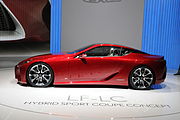


Tidak ada komentar: